Coffee Bean Grade AA, G1, SHB Raw Bean grading method introduction to Ethiopia Kenya Coffee grading
Kenya AA, Yega Xuefei G1, Blue Mountain one, these names are no stranger to everyone, followed by letters or numbers that represent the grade of these coffee beans.
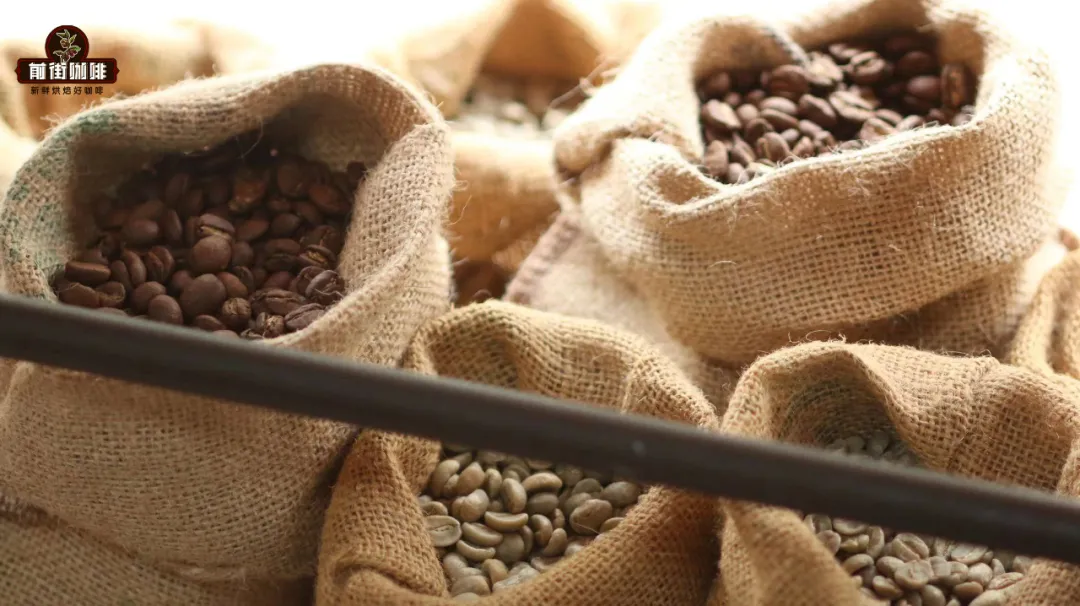
The grade of raw beans is a grading system suitable for the quality of coffee developed by each coffee-producing country according to its own situation. There are also some differences in the perspectives and standards for judging the quality of coffee in each country. Generally speaking, the establishment of stable and reasonable grading standards can promote the recognition of domestic coffee by international buyers. The more common ones are Ethiopia's coffee based on the number of defects, G1, which is the best coffee in Ethiopia, with no more than 3 defects per 300 grams of samples. Followed by G2, the number of defects per 300g sample is less than 12. These two grades of Essel beans are the most common on the market. These two grades of coffee belong to Ethiopia's boutique coffee category. Kenya's coffee grading system is divided by size, from big to small: e, AA, AB, C, PB, TT, T, MH/ML, but the only coffee beans we can actually come into contact with are AA, AB and PB,E, which are very rare and the largest pellet coffee beans (more than 18 mesh). Basically, the quantity is very small and difficult to meet. The most common is AA, the most common large-grain coffee bean in Kenya, with a mesh of 17-18 mesh. AB is a smaller coffee bean with a mesh of 15-16 mesh, which is also a good choice.
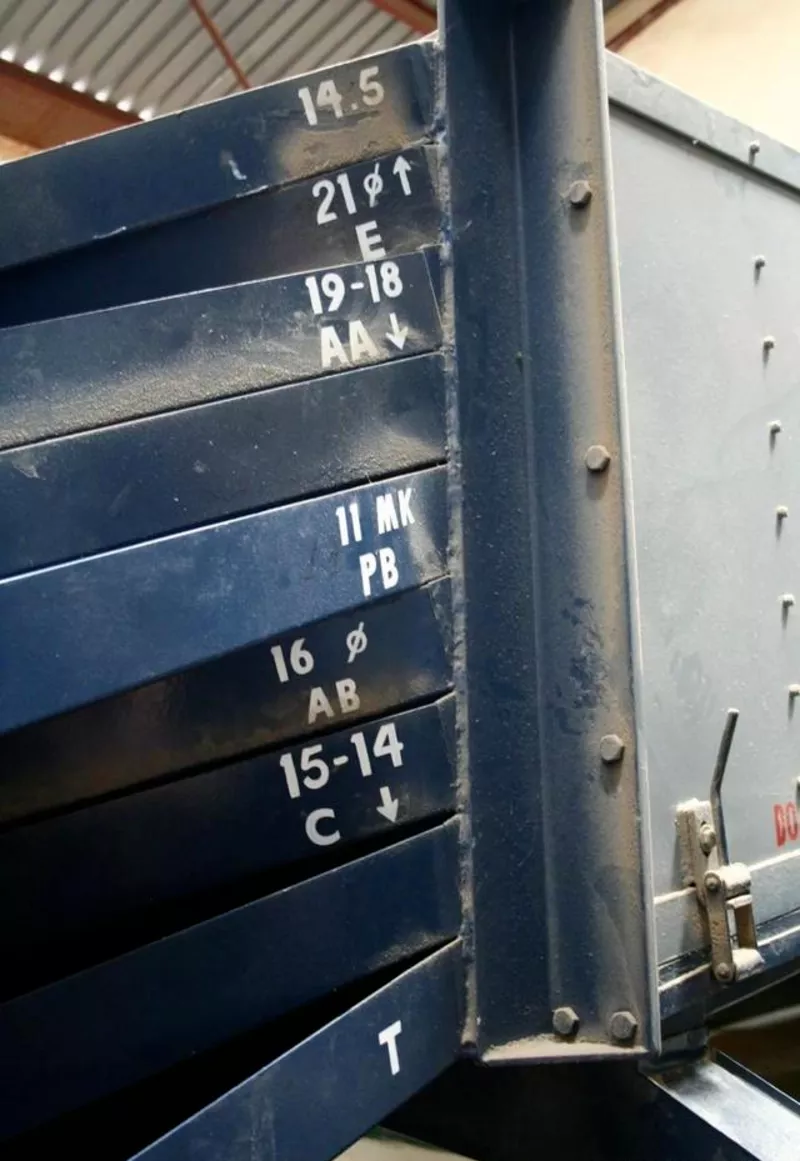
Another special kind is PB, or "round bean", which is a coffee fruit with only one seed, with an order of about 14-15 mesh. Because of the existence of the special shape, it can be singled out and sold at the price of AA (otherwise it is C grade). Except for these higher grades, the other grades are usually digested internally (shipping out is at a loss of freight). There are also defects and size are taken into consideration, such as Indonesia, Jamaica and Brazil, Indonesia is the most common G1 18 mesh, G1 is the number of defects less than 11 (300g), 18 mesh refers to the size of raw beans, generally this level is Indonesia's highest national standard grade, of course, like PWN gold Mantenin standard is higher, the quality is also better (PWN enterprise standard). Just like the authentic Blue Mountain Coffee is also divided into four grades, NO.1, NO.2, NO.3, PB, as we say, Blue Mountain one is actually NO.1 grade coffee beans, with more than 17 mesh and less than 2% defects.
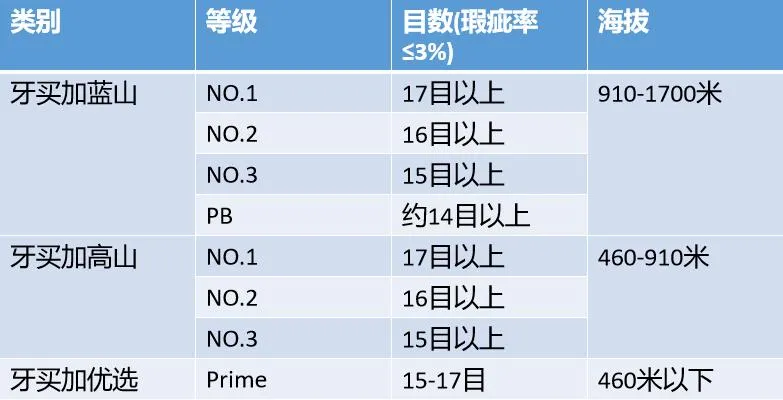
Brazil's highest grade is NY2, and there is no NY1 grade. NY2 requires 6 defects, 17-18 mesh, and the cup rating is FC (fine cup) or GC (good cup).
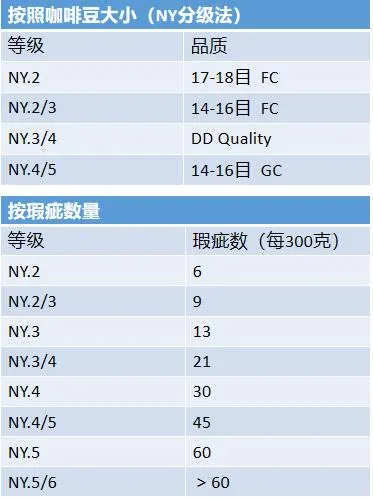
There are a large number of Central and South American countries are classified by hardness or altitude. Costa Rica, Panama and Guatemala are mainly classified by hardness. The best grade is SHB (extremely hard beans, above 1400 meters above sea level) and the second is HB (hard beans, 1200-1400 meters above sea level).
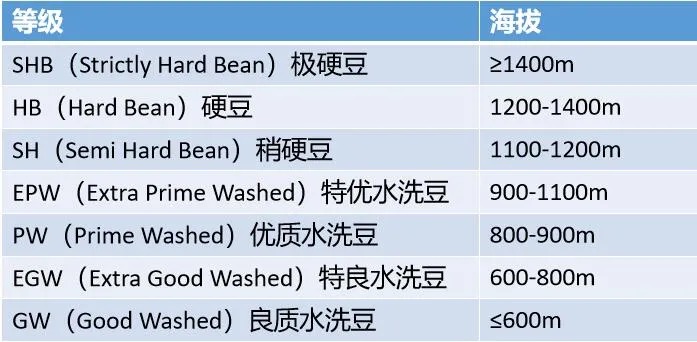
The countries dominated by El Salvador and Honduras are divided by altitude, the highest grade is SHG (extreme highlands, above 1200 meters above sea level) and HG (highlands, 9-1200 meters above sea level).

Among these many standards, you will find that the producing country will develop a favorable grading method, Ethiopia cannot use size-based grading, nor can Jamaica use altitude as a grading. The main impact of these graded coffee beans is the price. Is to enable international raw bean buyers to more clearly distinguish the quality of coffee beans in the country. In fact, when consumers buy cooked beans, the grade of raw beans in the national standard can almost be ignored. Notice that almost all the manor beans bought in the coffee shop are of the highest grade, and you rarely wonder whether the coffee beans in Panama are SHB or HB, because SHB is already the norm for manor cultivation. As for Essel's G1 and G2, during the baking stage, the baker should not like to see obvious defective beans poured into his baker. yes, before baking, a sieve check will be carried out to screen out the defective beans visible to the naked eye, and 1 or 2 defects will be selected after baking. In this case, it is no longer meaningful to use the raw bean grade standards of G1 and G2 to discuss.
Important Notice :
前街咖啡 FrontStreet Coffee has moved to new addredd:
FrontStreet Coffee Address: 315,Donghua East Road,GuangZhou
Tel:020 38364473
- Prev

Introduction to the brewing method parameters of deep-roasted hand-brewed coffee beans is moderate roasting suitable for hand-brewing?
This video was brushed by Qianjie in an online surfing three years ago. Unexpectedly, Qianjie was pushed again by big data recently, so Qianjie plans to share this surfing method with everyone. The process is really very simple and very enjoyable. Https://www.youtube.com/watc
- Next

Comparison of the performance of coffee hand mill and electric bean mill is there a big difference in flavor between hanging-ear coffee and hand-brewed coffee?
If you want to talk about the choice between hand rush and hanging ear, as a half barista, I do not hesitate to choose hand rush, how can I compare the flavor with my hand? As previously introduced in the front street, the formal hand flushing uses freshly ground coffee beans and filter cups, which can not be compared with the ears of pre-ground coffee beans.
Related
- Beginners will see the "Coffee pull flower" guide!
- What is the difference between ice blog purified milk and ordinary milk coffee?
- Why is the Philippines the largest producer of crops in Liberia?
- For coffee extraction, should the fine powder be retained?
- How does extracted espresso fill pressed powder? How much strength does it take to press the powder?
- How to make jasmine cold extract coffee? Is the jasmine + latte good?
- Will this little toy really make the coffee taste better? How does Lily Drip affect coffee extraction?
- Will the action of slapping the filter cup also affect coffee extraction?
- What's the difference between powder-to-water ratio and powder-to-liquid ratio?
- What is the Ethiopian local species? What does it have to do with Heirloom native species?

